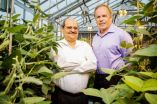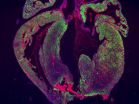(Press-News.org) In 2005, NASA's Cassini spacecraft sent pictures back to Earth depicting an icy Saturnian moon spewing water vapor and ice from fractures, known as "tiger stripes," in its frozen surface. It was big news that tiny Enceladus—a mere 500 kilometers in diameter—was such an active place. Since then, scientists have hypothesized that a large reservoir of water lies beneath that icy surface, possibly fueling the plumes. Now, using gravity measurements collected by Cassini, scientists have confirmed that Enceladus does in fact harbor a large subsurface ocean near its south pole, beneath those tiger stripes.
"For the first time, we have used a geophysical method to determine the internal structure of Enceladus, and the data suggest that indeed there is a large, possibly regional ocean about 50 kilometers below the surface of the south pole," says David Stevenson, the Marvin L. Goldberger Professor of Planetary Science at Caltech and an expert in studies of the interior of planetary bodies. "This then provides one possible story to explain why water is gushing out of these fractures we see at the south pole."
Stevenson is one of the authors on a paper that describes the finding in the current issue of the journal Science. Luciano Iess of Sapienza University of Rome is the paper's lead author.
During three flybys of Enceladus, between April 2010 and May 2012, the scientists collected extremely precise measurements of Cassini's trajectory by tracking the spacecraft's microwave carrier signal with NASA's Deep Space Network. The gravitational tug of a planetary body, such as Enceladus, alters a spacecraft's flight path ever so slightly. By measuring the effect of such deflections on the frequency of Cassini's signal as the orbiter traveled past Enceladus, the scientists were able to learn about the moon's gravitational field. This, in turn, revealed details about the distribution of mass within the moon.
"This is really the only way to learn about internal structure from remote sensing," Stevenson says. In fact, more precise measurements would require the placement of seismometers on Enceladus's surface—something that is certainly not going to happen anytime soon.
The key feature in the gravity data was a so-called negative mass anomaly at Enceladus's south pole. Put simply, such an anomaly exists when there is less mass in a particular location than would be expected in the case of a uniform spherical body. Since there is a known depression in the surface of Enceladus's south pole, the scientists expected to find a negative mass anomaly. However, the anomaly was quite a bit smaller than would be predicted by the depression alone.
"So, you say, 'Aha! This is compensated at depth,'" Stevenson says.
Such compensation for mass is commonly found on planetary bodies, including on Earth. In some cases, the absence of material at the surface is compensated at depth by the presence of denser material. In other cases, the presence of extra material at the surface is compensated by the existence of less dense material at depth. In fact, when the first gravity measurements were made in India, people were struck by the fact that Mount Everest did not seem to produce much of an effect. Today we know that, like most mountains on Earth, Mount Everest is compensated by a low-density root that extends many tens of kilometers below the surface. In other words, the material protruding above the surface is compensated by a reduction of density at depth.
In the case of Enceladus, the opposite is true. The absence of material at the surface is compensated at depth by the presence of material that is denser than ice. "The only sensible candidate for that material is water," Stevenson says. "So if I have this depression at the south pole, and I have beneath the surface 50 kilometers down a layer of water or an ocean, that layer of water at depth is a positive mass anomaly. Together the two anomalies account for our measurements."
Although no one can say for certain whether the subsurface ocean supplies the water that has been seen spraying out of the tiger stripes on Enceladus's surface, the scientists say that it is possible. The suspicion is that the fractures—in some way that is not yet fully understood—connect down to a part of the moon that is being tidally heated by the globe's repeated flexing as it traces its eccentric orbit. "Presumably the tidal heating is also replenishing the ocean," Stevenson says, "so it is possible that some of that water is making its way up through the tiger stripes."
INFORMATION:
The paper is titled "The Gravity Field and Interior Structure of Enceladus." Additional coauthors are Marzia Parisi, Douglas Hemingway, Robert A. Jacobson, Jonathan I. Lunine, Francis Nimmo, John W. Armstrong, Sami W. Asmar, Maria Ducci, and Paolo Tortora. The work was supported by the Italian Space Agency and by NASA through the Cassini project. The Cassini-Huygens mission is a cooperative project of NASA, the European Space Agency, and the Italian Space Agency. The Jet Propulsion Laboratory manages the mission for NASA's Science Mission Directorate.
Gravity measurements confirm subsurface ocean on Enceladus
2014-04-03
ELSE PRESS RELEASES FROM THIS DATE:
'Unzipping' poplars' biofuel potential
2014-04-03
EAST LANSING, Mich. — What began 20 years ago as an innovation to improve paper industry processes and dairy forage digestibility may now open the door to a much more energy- and cost-efficient way to convert biomass into fuel.
The research, which appears in the current issue of Science, focuses on enhancing poplar trees so they can break down easier and thus improving their viability as a biofuel. The long-term efforts and teamwork involved to find this solution can be described as a rare, top-down approach to engineering plants for digestibility, said Curtis Wilkerson, ...
Study shows more than half of high-risk alcohol users report improvement after surgery
2014-04-03
BOSTON – Much has been reported about the potential for increased risk of alcohol misuse after weight loss surgery (WLS), with most theories pointing to lower alcohol tolerance and a longer time to return to a sober state after surgery, but a new study from Beth Israel Deaconess Medical Center suggests that upwards of half of high-risk drinkers are actually less likely to report high-risk drinking behavior after weight loss surgery.
The results appear in the journal, Surgery for Obesity and Related Diseases.
"This is the first study to show that high-risk drinking ...
Aging workforce requires new strategies for employee retention, MU researcher says
2014-04-03
COLUMBIA, Mo. – As more baby boomers reach retirement age, state governments face the likelihood of higher workforce turnover. For example, in the state of Missouri, more than 25 percent of all active state employees will be eligible to retire by 2016. Such large numbers of retirees threaten the continuity, membership and institutional histories of the state government workforce, according to Angela Curl, assistant professor in the University of Missouri School of Social Work. In a case study of the state of Missouri's Deferred Retirement Option Provision (BackDROP), Curl ...
Scientists say new computer model amounts to a lot more than a hill of beans
2014-04-03
CHAMPAIGN, Ill. — Crops that produce more while using less water seem like a dream for a world with a burgeoning population and already strained food and water resources. This dream is coming closer to reality for University of Illinois at Urbana-Champaign researchers who have developed a new computer model that can help plant scientists breed better soybean crops.
Under current climate conditions, the model predicts a design for a soybean crop with 8.5 percent more productivity, but using 13 percent less water, and reflecting 34 percent more radiation back into space, ...
Dress and behavior of mass shooters as factors to predict and prevent future attacks
2014-04-03
New Rochelle, NY, April 3, 2014–In many recent incidents of premeditated mass shooting the perpetrators have been male and dressed in black, and may share other characteristics that could be used to identify potential shooters before they commit acts of mass violence. Risk factors related to the antihero, dark-knight persona adopted by these individuals are explored in an article in Violence and Gender, a new peer-reviewed journal from Mary Ann Liebert, Inc., publishers. The article is available free on the Violence and Gender website at http://www.liebertpub.com/vio.
In ...
Ouch! Computer system spots fake expressions of pain better than people
2014-04-03
BUFFALO, N.Y. — A joint study by researchers at the University of California, San Diego, the University at Buffalo, and the University of Toronto has found that a computer–vision system can distinguish between real or faked expressions of pain more accurately than can humans.
This ability has obvious uses for uncovering pain malingering — fabricating or exaggerating the symptoms of pain for a variety of motives — but the system also could be used to detect deceptive actions in the realms of security, psychopathology, job screening, medicine and law.
The study, "Automatic ...
New study casts doubt on heart regeneration in mammals
2014-04-03
The mammalian heart has generally been considered to lack the ability to repair itself after injury, but a 2011 study in newborn mice challenged this view, providing evidence for complete regeneration after resection of 10% of the apex, the lowest part of the heart. In a study published by Cell Press in Stem Cell Reports on April 3, 2014, researchers attempted to replicate these recent findings but failed to uncover any evidence of complete heart regeneration in newborn mice that underwent apex resection.
"Our results question the usefulness of the apex resection model ...
Hummingbirds' 22-million-year-old history of remarkable change is far from complete
2014-04-03
The first comprehensive map of hummingbirds' 22-million-year-old family tree—reconstructed based on careful analysis of 284 of the world's 338 known species—tells a story of rapid and ongoing diversification. The decade-long study reported in the Cell Press journal Current Biology on April 3 also helps to explain how today's hummingbirds came to live where they do.
Part of the secret to the birds' remarkable success lies in the formation of nine principal groups or clades, hummingbirds' unique relationship to flowering plants, and the birds' continued spread into new ...
Lactase persistence alleles reveal ancestry of southern African Khoe pastoralists
2014-04-03
In a new study a team of researchers lead from Uppsala University show how lactase persistence variants tell the story about the ancestry of the Khoe people in southern Africa. The team concludes that pastoralist practices were brought to southern Africa by a small group of migrants from eastern Africa. The study is published in Current Biology today.
"This is really an exciting time for African genetics. Up until now, routes of human migration in Africa were inferred mostly based on linguistics and archaeology, now we can use genetics to test these hypotheses." says ...
Cancer and the Goldilocks effect
2014-04-03
Researchers at the University of California, San Diego School of Medicine have found that too little or too much of an enzyme called SRPK1 promotes cancer by disrupting a regulatory event critical for many fundamental cellular processes, including proliferation.
The findings are published in the current online issue of Molecular Cell.
The family of SRPK kinases was first discovered by Xiang-Dong Fu, PhD, professor in the Department of Cellular and Molecular Medicine at UC San Diego in 1994. In 2012, Fu and colleagues uncovered that SPRK1 was a key signal transducer ...




